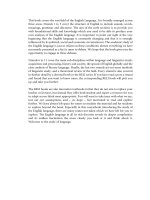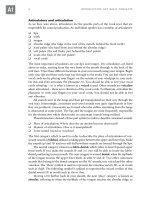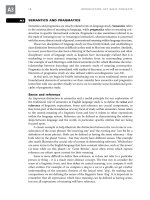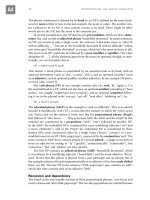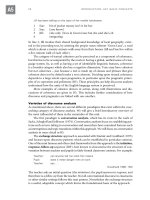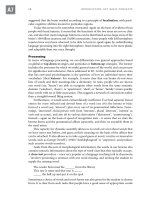Introdungcing English language part 12 ppt
Bạn đang xem bản rút gọn của tài liệu. Xem và tải ngay bản đầy đủ của tài liệu tại đây (227.2 KB, 6 trang )
52 INTRODUCTION: KEY BASIC CONCEPTS
is generally known in the school as ‘Asian Wall’. Girls stand around in their high plat-
form shoes, skinny bell-bottoms, and very small black T-shirts, with hips cocked. As
they toss their heads, their long sleek black hair (in some cases tinted brown) swishes
across their waists, the slimness of which is emphasized by shiny belts. Some of them
talk to, lean on, quiet-demeanoured boys with baggy jeans and baggy shirts, with hair
long on the top and shaved at the bottom. Linda turns away from her group of friends
with a characteristic head toss, bringing her hair around her shoulders; and with an
exaggerated high-rise intonation on the pronoun, she calls to a boy who is standing
nearby. ‘What are you?’ Another girl, Adrienne, who happens to be walking by,
answers on his behalf. ‘He’s Japanese-Filipino.’ The boy smiles silently, and Linda turns
back to her friends.
Eckert and McConnell-Ginet (1999: 121)
In addition to these ethnographic observations, Eckert also carries out very detailed
quantitative analyses from recorded data of phonological and grammatical linguistic
variables from a large number of realisations of phonetic and grammatical features
over time. These quantitative studies are statistically tested, and enable her to make
valid and reliable arguments from her findings regarding language, regional identi-
ties, social identities and adolescence.
Eckert (2009) contrasts the ethnographic approach which she took at Belten High
with what she describes as a ‘quick and dirty’ method of briefly going into various
other schools in the surrounding area to examine the phonological manifestations
of her adolescent identity categories. This method, which shares similarities with
Labov’s ‘rapid’ method described above, enabled Eckert to place her phonological ana-
lysis on a broad geographical continuum for the whole of the suburban region where
her research took place.
In a reflexive evaluation of her own methodological practice, she notes that the
‘quick and dirty’ method lacked the textual detail and access to communities of prac-
tice which were so crucial in being able to characterise how adolescent groups use
linguistic strategies to signal their identities. She concludes that ‘I was never as sure of
the status of my data in the other schools as I was at Belten’ (2009: 150).
Once the decision regarding methodological paradigm(s) for conducting a par-
ticular English language study has been made, there are other decisions regarding data
collection techniques and ethics that need to be taken. We will explore some of the
most significant of these issues in B12.
LANGUAGE THEORIES
Almost everything we have said about language in the first twelve strands in this book
has been contentious at different points in history. The ways in which people described
language 300 years ago (see B8 and C8) were very different from more recent descrip-
tions. Even observations from only 30 years ago which gradually became the general
consensus (the paradigm) have gradually been questioned, rejected, and replaced by
A13
LANGUAGE THEORIES 53
new perspectives. No doubt our current thinking will also soon be superseded in due
course.
This does not mean that linguists are generally incompetent: the fact that the field
of study is constantly being revised is a consequence of the fact that language in
general is immensely complicated and difficult to study. It ranges from material and
measurable phenomena (writing, sounds) all the way to things that are very difficult
to get at (meanings, implications). The close connections between language, thought
and consciousness also take you very quickly to difficult philosophical considerations.
Language covers the things that an individual says and writes, as well as the variations
across large groups of people over geographical distances and throughout history.
Language itself is a universal capability of all humans, and the particular languages
that societies use have always changed over time.
Furthermore, because there are so many different dimensions to language, it is
impossible to hold them all in equal and perfectly objective balance at the moment
of study – every researcher comes to the study of language with ideas, ideologies,
commitments and perspectives that influence which part of language they choose to
study, which questions they decide to ask, which methods they decide to employ, and
how their findings can best be interpreted from their own angle.
Linguistics as a social science
The objective of language study – like any properly progressive discipline – is to gain
a better understanding than the state of existing knowledge. The best way of ensuring
this development is to be healthily sceptical of all ideas, and ask questions to deter-
mine what is the basis of those ideas. Being critical does not simply mean finding fault
and rejecting others’ work: there is an ethical imperative on you also to be creative
and suggest solutions where you find problems. The general scientific principle – even
for a complex social science like linguistics – that underlies all this is the notion of
falsifiability. Any statement you can make about an aspect of language must be able
to be disproven. For example, of the two statements:
‘Language is the blood of the soul into which thoughts run and out of which they
grow’ (poet Oliver Wendell Holmes), and
‘Language is always changing’ (linguist David Crystal)
only the second can be proven false – for example, you could try to find a living lan-
guage somewhere in the world that has remained exactly the same for at least three
generations. You would only need to find one contrary example to falsify the general
statement – or at least force you to amend the word ‘always’ to something weaker,
like ‘tends to change in general’. The first statement is certainly poetic and certainly
meaningful, but it is not possible to disprove it because as a metaphor it is already
literally false, and the range of meanings it might evoke in different interpretations
means that it does not say anything precisely. In short, the first sentence is a poetic
and expressive statement of opinion and viewpoint that is untestable, and the second
is a scientific statement that is testable and disprovable.
Falsifiability must apply to all assertions in language study, from simple statements
like the one above to entire theoretical frameworks, such as the way in which we carved
up the constituents of clauses in A4 and B4. All statements about language can then
54 INTRODUCTION: KEY BASIC CONCEPTS
be regarded as theories offered as descriptions of language, available to be falsified.
They cannot be proven true, since you can never say what new evidence, new tech-
niques or new approaches might emerge in the future to disprove the theory, so the
best we can do is to hold a set of theories about language which are as good as we can
manage for the moment. This means that in language study, as in any analytical study,
everything in this (or any other) book is best thought of as being only provisionally
not wrong.
Different approaches to language study
Of course, when a theory receives criticism, or a new perspective is suggested, not every-
one always agrees that the original theory is disproven. Some adherents to the origi-
nal theory will defend it, arguing against the criticism. Others will adapt the original
theory to meet the challenge offered by the new proposal. And, of course, some
researchers will have their positions changed by the new debate and will work to develop
other theories too. This process means that the historical development of modern lin-
guistics has not been a neat march from one descriptive position to another, with every-
one in perfect step. If you take a snapshot at virtually any historical moment in linguistics,
you will find adherents of several contradictory and complementary theories existing
at once and debating with each other. On occasion, this has become so passionate
that one spat in the 1970s was even termed ‘the linguistics wars’.
For example, the study of language through most of recorded history has been
through rhetoric (learning the art of speaking and persuading) and through prescriptive
treatises on grammar and good usage. Through the later nineteenth century, philology
was the name for language study, with a strong focus on the historical development
of languages and especially the etymology of words, on sound-change rules in pronun-
ciation, and also encompassing literary history.
Around the turn of the twentieth century, linguists began to be interested not so
much in these diachronic developments but in more synchronic patterns, looking at
a snapshot of the language of the present as a system of structures and symbols. This
was structuralism, which dominated language study for the first half of the twentieth
century. Structuralism shifted the emphasis of study away from historical processes and
onto social ones, which meant that links between linguistics and anthropology were
easier to make.
In the 1950s, a revolution in language study occurred in the name of generativism,
which created the discipline of modern linguistics. In some respects, generativism con-
tinued the structuralist approach of aiming to discern underlying systematic patterns
and structures in language, rather than being interested in language history or social
variation. Indeed, generativists explicitly claimed to be interested only in a speaker’s
underlying competence rather than their observed performance, though of course
their intuitions about well-formedness constituted important information that shed
light on deeper structures. In other respects, generativism marked a break with
structuralism, in the disregard of social, performative aspects of language. Generativists
believed that the capacity for language – and even many of its deepest structural
patterns – was innate in humans.
Focusing on syntax, constituent structure, and the rules by which different
phrases and sequences could be transformed below the surface performance of
LANGUAGE THEORIES 55
language, generativism aimed to develop simple mathematical formulae that could
account for every well-formed grammatical sequence in English. These syntactic
rules, it was argued, could generate any well-formed sentence. Generativism, through
its various modifications over the last 50 years, has remained a formal grammar. It
distinguishes surface structure (the manifestation of language in the world, actual utter-
ances, part of performance) from deep structure (the underlying patterns and trans-
formations that determine the language). It is the deep structure that this approach
has mainly been interested in, to the extent that when people talk about ‘theoretical
linguistics’, they almost always mean generativism, as opposed to other, more applied
forms of linguistics.
Alongside this approach, and developing out of anthropological structuralism, a
functionalist tradition emerged in language study, largely at odds with generativism.
Functionalism regarded language as part of social practice rather than a separable
module, and so there is no focus on syntax but rather an argument that syntax and
semantics are mutually influential, no focus on formal rules but rather an emphasis on
systemic descriptions that allow for the variations in actual usage and communica-
tiveness. The most famous functional model of language is systemic functional
grammar (SFG). Because of its aim (simply put) of theorising what language does rather
than what it is, SFG has proven useful in discourse analysis and the exploration of
sociological and political contexts of language use.
Though generativism appears to be a branch of highly abstract psychology, and
functionalism a branch of sociology and anthropology, in practice each draws on
evidence from both these domains. The intuitive tests applied by generativists to their
formal descriptions are placed into the public, social domain for approval or not by
others. The systemic descriptions produced by functionalist grammarians correspond
quite well with psychological matters of cognition, perception and attention.
Generativism takes a formal approach to language, assuming that the important
facets of language can be represented by notational principles, rules and explicit para-
meters. One way this assumption can be sustained is to define those important facets
of language as including only those aspects of language that can be accounted for in
this way. So generativism is often said to be modular, with dimensions such as inter-
pretation and social communicativeness explicitly excluded from the definition of
linguistics.
Functionalism takes a systemic approach to language, assuming that language is
not modular but integrated in principled ways. So, for example, the lexicogrammat-
ical choices made at clause level are implicated in and by the interpersonal situation
of the speaker and the sort of text and discourse they imagine they are involved in.
A functionalist’s view of language is thus broader than a generativist’s, including social
symbols and conventional codes, and functionalism is often allied with the social-
linguistic field of social semiotics. What functionalism gains in a broader definition of
language, of course, it loses in a less precisely manageable analytical account, from a
generativist perspective.
In recent years, a cognitivist approach has developed across the social sciences
that has also influenced language study in the form of a cognitive linguistics.
Cognitivism takes an ‘embodied’ approach to language, arguing that – far from
language being self-contained and modular – there are evolutionary, biophysical, and
56 INTRODUCTION: KEY BASIC CONCEPTS
psychologically plausible connections between the material nature of our bodies
in the world and the ways we cognise, understand and articulate the world and our
experience in language and thought.
Cognitivists argue, for example, that the way our mental attention is deployed
across a clause or discourse situation is simply an adapted case of the way our visual
attention has worked since the days before we developed language as a species.
Cognitivism is basically a functional model, in that it places communicativeness at
the heart of its approach, but it draws heavily on psychology and claims psychological
validity for its models – furthermore, many of the proponents of cognitive linguistics
in the 1980s were former generativists, disillusioned as a result of the linguistics wars
of the previous decade.
At the moment, you will find the field of linguistics populated by generativists,
functionalists, cognitivists and others, all with their own research programmes,
books, journals, courses and conferences. From time to time, they will also engage
with each other and criticise, review or adapt developments from the other projects.
Underlying each of their approaches are fundamentally different views of the relationships
between language, thought and society that are not obviously reconcilable. Though
each group would argue that their own paradigm best fits the data as they see it,
the fact is that there are advantages and problems with all of these approaches. Their
different views will be the field of discussion in unit B13.
SECTION B
DEVELOPMENT:
ASPECTS OF
ENGLISH
SWIN|KCrEIB1Qqc8svpQueSEh0w==|1282035821



